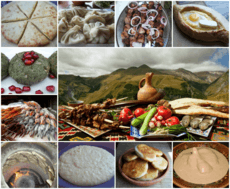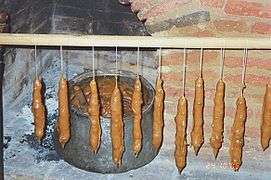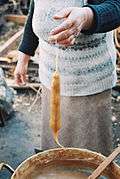Churchkhela
 | |
| Type | Confectionery |
|---|---|
| Place of origin | Georgia |
| Main ingredients | Grape must, nuts, flour |
|
| |
 |
| Part of the series on |
| Georgian cuisine ქართული სამზარეულო |
|---|
|
Foods and dishes
|
Churchkhela (Georgian: ჩურჩხელა, Georgian pronunciation: [tʃʰurtʃʰxɛlɑ]) is a traditional Georgian[1][2][3] candle-shaped candy. The main ingredients are grape must, nuts and flour. Almonds, walnuts, hazel nuts and sometimes raisins are threaded onto a string, dipped in thickened grape juice or fruit juices and dried in the shape of a sausage.[4][5][6][7]
Outside Georgia
Churchkhela and its varieties are popular in several countries besides Georgia, such as Iran, Armenia, Azerbaijan, Cyprus,[8] Greece, Russia,[9] Ukraine, and Turkey.[10][4] In Persian, it's known as "Lævascæck Adjili" (لواشک آجیلی)[]. In Armenian, Greek, and Turkish it is known as "sujuk", which is actually a dry sausage. To distinguish the two, it is sometimes referred to as "sweet sujukh" (քաղցր սուջուխ, kaghtsr sujukh) in Armenian[11] and cevizli sucuk ("walnut sujuk") in Turkish.[12] It is known in Cypriot Greek as soutzoukos (σουτζούκος or σουτζιούκκος)[8][13][14] and as soutzouki (σουτζούκι) in Greece.[15] The Cypriot variety is made by dipping strings of almonds into jelly, called palouzes or moustalevria.
Preparation
Churchkhela is a homemade Georgian product. Georgians usually make Churchkhela in Autumn when the primary ingredients, grapes and nuts, are harvested. It is a string of walnut halves that have been dipped in grape juice called Tatara or Phelamushi (grape juice thickened with flour), and dried in the sun.[16] No sugar is added to make real Churchkhela. Instead of walnuts, sometimes nuts or almonds are used in the regions of west Georgia. The shape of Churchkhela looks like a candle, but some people say it looks like a sausage. Georgian warriors carried Churchkhelas with them because they contain many calories. The best Churchkhela is made in Kakheti region, which is renowned as the motherland of wine.
Must is placed in a large bronze cauldron (called chartzin or kazani) and heated slowly. A small amount of a special white earth called asproi is added to the boiling must and causes impurities to rise to the surface, where they are collected and removed. It is possible to substitute asproi, when not available, with lager beer, which has a similar result. Once the cleansing process is complete, the must is left to cool. Next, flour is added while stirring and heating the mixture. When it reaches the right consistency, based on the rate of steam bubbles and the viscosity of the mixture, it is removed from the heat. The mix, called palouzes, is now ready for use in the next step in the process of making soutzoukos, which consists of preparing the nuts for dipping.
Before they are threaded, the nuts have to be shelled and dipped into water in order to soften them. Once soft enough, they are strung onto 2-3 meter-long threads. The strings are dipped in the palouzes mixture until completely covered. This process is repeated several times (usually three times) until the soutzoukos has the desired thickness. Soutzoukos strings are then left to dry for 5–6 days. They are then ready for consumption or storage, even though some people like to eat soutzoukos fresh.
Consumption
Churchkhela is a snack for in-between and is also served as a dessert during the New Year and Christmas celebrations.
Gallery
See also
References
- ↑ Goldstein, Darra (1999). The Georgian Feast: The Vibrant Culture and Savory Food of the Republic of Georgia. University of California Press. p. 210.
- ↑ Чурчхела. langet.ru (in Russian). Culinary Dictionary of V.V. Pokhlebkin. 2002.
Грузинское национальное лакомство.
- ↑ Roufs, Timothy G.; Roufs, Kathleen Smyth (2014). Sweet Treats around the World: An Encyclopedia of Food and Culture. ABC-CLIO. p. 140.
- 1 2 Zeldes, Leah A. (2011-03-02). "Eat this! Rojik, something sweet from Armenia". Dining Chicago. Chicago's Restaurant & Entertainment Guide, Inc. Retrieved 2011-06-30.
- ↑ Кавказская кухня (Russian)
- ↑ На Кавказ за чурчхелой (Russian)
- ↑ Churchkhela
- 1 2 "Soutzoukos". hellenicaworld.com. Hellenica World.
Soutzoukos (Greek: σουτζούκος) is a popular tradional sweet of Cyprus.
- ↑ "Как сделать чурчхелу в домашних условиях [How to make churchkhela at home]" (in Russian). mail.ru. 10 October 2013.
- ↑ Procook.ru:Чурчхела (Russian)
- ↑ "Վրաստան այցելելու պատճառները՝ Buzzfeed-ի ֆոտաշարքում" (in Armenian). Tert.am. 5 November 2014.
չուրչխելա (քաղցր սուջուխ)
- ↑ "Going nuts in Pangaltı, Şişli". Hürriyet Daily News. 29 January 2010.
...the cevizli sucuk, a traditional, sausage-shaped candy made of walnuts sewn onto a string and dipped into thickened mulberry juice.
- ↑ Cyprus. Hunter Publishing. 1999. p. 231.
Soutzoukos is a solidified grape juice sweet made with almonds and formed into sausage-like rolls.
- ↑ "Σουτζιούκκος". foodmuseum.cs.ucy.ac.cy (in Greek). Cyprus Food Virtual Museum. Retrieved 30 November 2015.
- ↑ "Authentic Foods Soujoukos & Palouzes". cyprusfoodndrinks.com. Cyprus Food and Drinks.
Soujoukos (grape must roll): A similar name, soutzouki, is also used in Greece to denote the same product.
- ↑ Progress Tour. "Churchkhela". Retrieved 2012-11-19.
External links
-
 Media related to Churchkhela at Wikimedia Commons
Media related to Churchkhela at Wikimedia Commons
.jpg)

.jpg)

